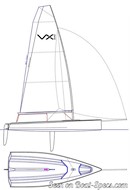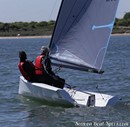VX Evo
Sailboat specifications
The VX Evo is a 15’8” (4.78m) single handed skiff (dinghy) designed by Bennett Yachting (New Zealand). She is built since 2017 by Ovington Boats (United Kingdom). She has been awarded "2017 - Sailing World - Boat of the Year: Best Dinghy" and "2017 - SAIL magazine - Best Performance Boat under 30ft".
VX Evo's main features
- Model
- VX Evo
- Hull type
- Monohull
- Category
- Single handed skiff (dinghy)
- Sailboat builder
- Sailboat designer
- Country
- United Kingdom
- Construction
- Fiberglass reinforced epoxy:
Sandwich PVC E-glass epoxy with carbon fiber reinforcements - First built hull
- 2017
- Last built hull
- Still in production
- Award(s)
- 2017: Sailing World - Boat of the Year: Best Dinghy
- 2017: SAIL magazine - Best Performance Boat under 30ft
- Appendages
- Centerboard : daggerboard
- Helm
- Single tiller
- Rudder
- Single transom hung rudder
- Unsinkable
- No
- Trailerable
- Yes
- Standard public price ex. VAT (indicative only)
- About11 900 €(2020)
VX Evo's main dimensions
- Hull length
- 15’ 8”4.78 m
- Beam (width)
- 5’ 8”1.74 m
- Light displacement (MLC)
- 181 lb82 kg
VX Evo's rig and sails
- Upwind sail area
- 111 ft²10.29 m²
- Downwind sail area
- 231 ft²21.44 m²
- Mainsail area
- 111 ft²10.29 m²
- Asymmetric spinnaker area
- 120 ft²11.15 m²
- Rigging type
- Cat boat Marconi (square top mainsail)
- Mast configuration
- Mast foot integrated on deck
- Rotating spars
- No
- Spreaders angle
- No spreader
- Spars construction
- Carbon fiber spars
VX Evo's performances
- Crew
- 1
- Upwind sail area to displacementiThe ratio sail area to displacement is obtained by dividing the sail area by the boat's displaced volume to the power two-thirds.
The ratio sail area to displacement can be used to compare the relative sail plan of different sailboats no matter what their size.
Upwind: under 18 the ratio indicates a cruise oriented sailboat with limited performances especially in light wind, while over 25 it indicates a fast sailboat. - 587 ft²/T54.52 m²/T
- Downwind sail area to displacementiThe ratio sail area to displacement is obtained by dividing the sail area by the boat's displaced volume to the power two-thirds.
The ratio sail area to displacement can be used to compare the relative sail plan of different sailboats no matter what their size. - 1223 ft²/T113.59 m²/T
- Displacement-length ratio (DLR)iThe Displacement Length Ratio (DLR) is a figure that points out the boat's weight compared to its waterline length. The DLR is obtained by dividing the boat's displacement in tons by the cube of one one-hundredth of the waterline length (in feet).
The DLR can be used to compare the relative mass of different sailboats no matter what their length:
a DLR less than 180 is indicative of a really light sailboat (race boat made for planning), while a DLR greater than 300 is indicative of a heavy cruising sailboat. - 441
- Critical hull speediAs a ship moves in the water, it creates standing waves that oppose its movement. This effect increases dramatically the resistance when the boat reaches a speed-length ratio (speed-length ratio is the ratio between the speed in knots and the square root of the waterline length in feet) of about 1.2 (corresponding to a Froude Number of 0.35) . This very sharp rise in resistance, between speed-length ratio of 1.2 to 1.5, is insurmountable for heavy sailboats and so becomes an apparent barrier. This leads to the concept of "hull speed".
The hull speed is obtained by multiplying the square root of the waterline length (in feet) by 1.34. - 3.20 knots
VX Evo's auxiliary engine
- Engine(s)
- No engine
VX Evo's accommodations and layout
- Cockpit
- Open aft cockpit



Ovington Boats VX Evo sailplan - - 2/9
Picture extracted from the commercial documentation © Ovington Boats
Picture extracted from the commercial documentation © Ovington Boats


Ovington Boats VX Evo sailing - - 3/9
Picture extracted from the commercial documentation © Ovington Boats
Picture extracted from the commercial documentation © Ovington Boats


Ovington Boats VX Evo sailing - - 4/9
Picture extracted from the commercial documentation © Ovington Boats
Picture extracted from the commercial documentation © Ovington Boats


Ovington Boats VX Evo sailing - - 5/9
Picture extracted from the commercial documentation © Ovington Boats
Picture extracted from the commercial documentation © Ovington Boats


Ovington Boats VX Evo sailing - - 6/9
Picture extracted from the commercial documentation © Ovington Boats
Picture extracted from the commercial documentation © Ovington Boats


Ovington Boats VX Evo sailing - - 7/9
Picture extracted from the commercial documentation © Ovington Boats
Picture extracted from the commercial documentation © Ovington Boats


Ovington Boats VX Evo sailing - - 8/9
Picture extracted from the commercial documentation © Ovington Boats
Picture extracted from the commercial documentation © Ovington Boats


Ovington Boats VX Evo sailing - - 9/9
Picture extracted from the commercial documentation © Ovington Boats
Picture extracted from the commercial documentation © Ovington Boats
Similar sailboats that may interest you:
Sailboats
First built hull
Hull length
1995
9’ 2”2.8 m
2001
15’ 8”4.8 m
1994
14’ 10”4.52 m
1995
13’ 1”4 m
2014
13’ 1”4 m
2010
14’ 1”4.3 m
2002
15’ 5”4.68 m
2001
13’ 11”4.25 m
2014
13’ 10”4.2 m
1992
16’ 5”5 m
2015
14’4.27 m
2009
13’ 11”4.23 m
2000
14’ 11”4.55 m
1995
15’ 2”4.64 m
2017
14’ 1”4.3 m